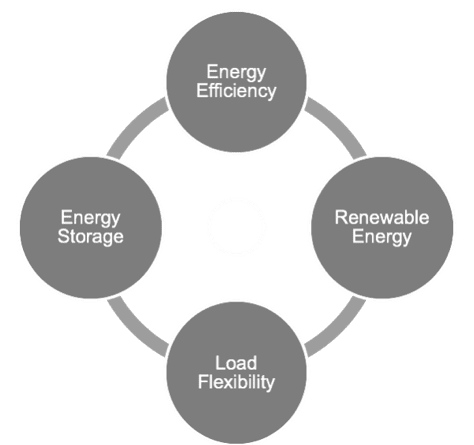low angle view of the skyscrapers in nyc

Innovation Opportunities in Grid-Interactive Efficient Buildings
What if buildings could communicate with the electric grid to save money and reduce their environmental impacts? Buildings drive up to 80 percent of the peak demand on the grid, and peak demand drives grid investments in generation, transmission, and distribution assets, so there is a huge opportunity to balance building demand with electricity system supply. Grid-interactive energy efficient buildings (GEBs) leverage technologies and strategies to address this issue through demand management and load flexibility. GEBs include an optimized blend of energy efficiency, energy storage, distributed energy generation, and load-flexible technologies that can match the needs of our evolving electricity system over time. The result is a more flexible building energy load profile with lower peaks that reduces building operating costs through demand-charge savings.
Grid-interactive efficient buildings (GEBs) use energy efficiency, storage, load flexibility, and renewable energy strategies to reduce costs to buildings and the utility
GEBs can provide a win-win solution for the building owner, utility, and society as a whole.
- Building owners can benefit as a result of energy and demand charge reduction. This will reduce a large commercial user’s electricity bills and operating costs while improving the building’s performance. Some building owners may also be able to sell electricity back to the grid, benefit from utility demand response programs, or leverage price arbitrage on wholesale energy markets.
- Utilities can benefit, as GEBs can help shift energy demand to times when cleaner and/or more affordable power are abundant. GEBs can also reduce the severity of major peaks or dips in demand that can be hard for utilities to accommodate. These qualities are especially important as more renewable energy and energy storage is added to buildings and the grid. Balancing load more effectively can help decrease costs for utilities, by avoiding investments in additional transmission, distribution, and generation assets.
- Society benefits, as GEBs help increase resilience, reduce the amount of fossil fuel generation needed, and save on energy bills. GEBs help the grid run more smoothly, and any cost savings that utilities see are ultimately passed on to customers who may enjoy lower electric bills as a result.
Earlier this year, RMI published a report in partnership with the US General Services Administration (GSA) showing the business case for GEBs to building owners, the impact on the GSA’s portfolio, and the potential societal value. This report shows how the GSA, the nation’s largest landlord, could save $50 million in annual cost savings and generate $70 million in value to grid users if it implemented these strategies. To take this work to the next level, RMI is supporting a federal effort to request information from industry to advance the state of knowledge and practice in GEBs.
Advancing GEBs: GSA Proving Ground and DOE HIT Catalyst Move the Needle
The General Services Administration Proving Ground (GPG) and the Department of Energy’s High Impact Technology (HIT) Catalyst programs have released a Request for Information (RFI) seeking technologies and solutions that will cost-effectively implement more comprehensive GEB strategies. The GPG and the DOE HIT Catalyst programs have a history of pushing the industry to research, develop, and deploy leading edge technologies that could experience a broad rollout across industry. This RFI is a first of its kind, as it is supporting GEBs strategies, which could be made up of a number of technology or controls solutions that coordinate the control of multiple building end-use systems, rather than one specific tool.
The GSA Proving Ground (GPG) is a program that has evaluated dozens of new building technologies in real-world operational settings and implemented them in federal benefits. This program helps technologies move from the R&D phase to widespread market acceptance while saving energy costs for the GSA and US taxpayers. To date, the program has yielded $16 million of annual avoided costs.
The Department of Energy’s HIT Catalyst program supports research and development in building system optimization and technology solutions for ultra-low energy buildings. The program provides technical resources and assistance to identify integration research and development priorities.
Below are the requirements listed in the GSA Proving Ground Solicitation. If you have any questions about the solicitation, we recommend that you review the information on the RFI solicitation page or the GSA website for this opportunity. Responses are due on December 9 by 11:59 PST.
Requirements for the GSA Proving Ground Solicitation #47PA0120N0001:
Participation in GPG or HIT Catalyst can increase market acceptance of new GEB solutions by validating real-world performance. Technology evaluations help inform public- and private-sector investment decisions, accelerating commercialization as well as adoption within the federal government and the commercial building industry. This RFI is a great opportunity to test out innovative ideas and make a lasting impact on the industry.
At a minimum, responses to the Request for Information should utilize technologies that advance building performance across four dimensions:
- Energy efficiency: reducing overall building energy
- Load shed: reducing peak demand for a short period of time
- Load shift: shifting the timing of energy use to minimize peak demand
- Modulation of electrical load at the sub-seconds to seconds level: the capability to provide small-scale, distributed grid stability and balancing services by automatically increasing or decreasing power demand or reactive power.
The technologies should:
- Integrate multiple building systems, enabling them to interact with each other and with the existing building control system and proposed software solution, and, if possible, with the utility grid
- Aggregate data and dynamically manage and coordinate loads, generation and storage to reduce, shift, shed, or modulate energy use in response to peak demand
- Demonstrate payback and value at the whole building level
- Provide ongoing access to data and training or support to the building operator
If you are interested in learning more or submitting a proposal, please refer to the GSA website. Responses are due on December 9 by 11:59 PST.
